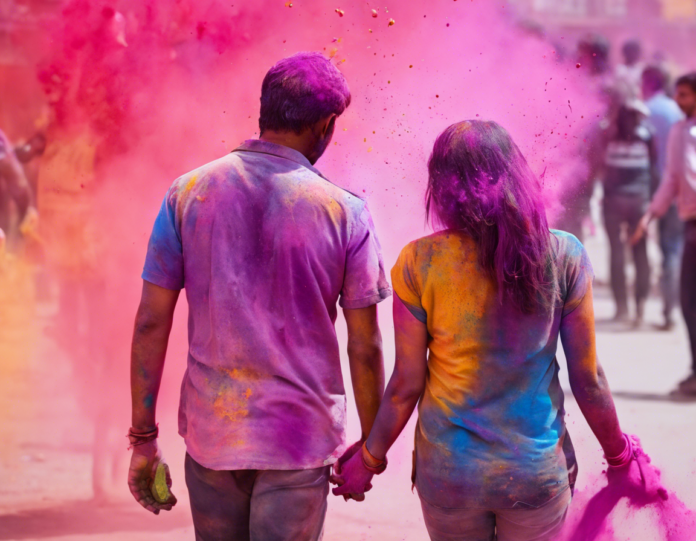Introduction
Holi, also known as the Festival of Colors, is a vibrant and joyous Hindu festival celebrated in India and around the world. This ancient festival signifies the victory of good over evil and the arrival of spring. The festival typically takes place in March, on the day after the full moon. Holi is a time for people to come together, play with colors, and celebrate with music, dance, and delicious food.
History of Holi
Holi has its roots in Hindu mythology and has been celebrated for centuries. One popular legend associated with Holi is the story of Holika and Prahlad. According to the myth, Holika, the sister of the demon king Hiranyakashipu, tried to kill Prahlad, a devotee of Lord Vishnu. She had a boon that made her immune to fire, so she sat on a pyre with Prahlad. However, due to Prahlad’s unwavering devotion, he emerged unharmed while Holika was consumed by the flames. This event symbolizes the victory of good over evil, which is commemorated during Holi.
Significance of Colors
Colors play a central role in Holi celebrations. People gather in public spaces and smear each other with brightly colored powders, known as gulal. This tradition of playing with colors is said to have originated from the story of Lord Krishna, who used to play pranks on the gopis by drenching them in water and colors. The use of colors during Holi is also believed to represent the various hues of spring and the blossoming of love and happiness.
Traditions and Customs
Holi is celebrated with various rituals and traditions that vary from region to region. One common custom is the lighting of bonfires the night before Holi, known as Holika Dahan. This ritual symbolizes the burning of Holika and represents the victory of good over evil. On the day of Holi, people gather to play with colors, dance to traditional music, and indulge in festive foods and drinks. Gujiya, a sweet dumpling filled with khoya, nuts, and dried fruits, is a popular Holi delicacy. Another tradition is the sharing of thandai, a refreshing drink made with milk, nuts, and aromatic spices, often infused with bhang (cannabis) for an added kick.
Celebrations Around the World
While Holi is primarily celebrated in India, it has gained popularity in other parts of the world as well. In countries like Nepal, Sri Lanka, and Bangladesh, Holi is observed with similar zeal and enthusiasm. In recent years, Holi festivals have been organized in cities across the globe, attracting people of all backgrounds to participate in the colorful festivities. These events typically feature music, dance performances, food stalls, and, of course, plenty of colors.
Tips for Celebrating Holi
- Wear old clothes that you don’t mind getting stained with colors.
- Use natural, eco-friendly colors to protect your skin and the environment.
- Apply oil or lotion on your skin and hair before playing with colors to make them easier to wash off later.
- Stay hydrated and protect your eyes during the celebrations.
- Respect other people’s boundaries and avoid forcing colors on anyone who doesn’t want to participate.
FAQs about Holi
- What is the significance of Holi in Hindu culture?
-
Holi is celebrated as a symbol of the victory of good over evil and the arrival of spring. It is also a time to mend broken relationships and celebrate with loved ones.
-
Why do people play with colors during Holi?
-
Playing with colors during Holi is a way to celebrate the colorful and vibrant spirit of spring, as well as to commemorate the playful antics of Lord Krishna.
-
What are the traditional foods and drinks served during Holi?
-
Popular Holi delicacies include gujiya, mathri, and papri chaat, while beverages like thandai and bhang lassi are commonly enjoyed during the festivities.
-
How is Holi celebrated in different parts of India?
-
Holi celebrations vary across India, with each region adding its unique customs and traditions to the festival. For example, in Mathura and Vrindavan, the birthplace of Lord Krishna, Holi is celebrated with great pomp and show.
-
Is it safe to participate in Holi celebrations if I have allergies or sensitive skin?
- If you have allergies or sensitive skin, it is advisable to use natural and organic colors during Holi. You can also protect your skin by applying a barrier cream or oil before playing with colors.
Conclusion
Holi is not just a festival of colors but a celebration of life, love, and togetherness. It is a time to let go of inhibitions, embrace joy and positivity, and strengthen bonds with friends and family. By understanding the history, significance, and traditions of Holi, we can truly appreciate the beauty and cultural richness of this colorful festival. So, this Holi, immerse yourself in the kaleidoscope of colors, dance to the rhythm of joy, and relish the sweetness of shared moments with loved ones. Happy Holi!
